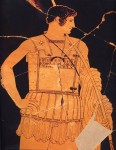 This isn’t breaking news or anything, but it’s news to me and I’ve been obsessing about it for 2 days. Greek armies from at least the 6th century B.C. through the Hellenistic period (the era after Alexander’s conquests when Greek military strength and cultural influence were at their peak) wore an armour made out of linen. It’s called linothorax, a thorax being an armoured chestpiece and lino being, well, linen.
This isn’t breaking news or anything, but it’s news to me and I’ve been obsessing about it for 2 days. Greek armies from at least the 6th century B.C. through the Hellenistic period (the era after Alexander’s conquests when Greek military strength and cultural influence were at their peak) wore an armour made out of linen. It’s called linothorax, a thorax being an armoured chestpiece and lino being, well, linen.
The famous floor mosaic of Alexander found in the House of the Faun in Pompeii depicts him wearing a linothorax. Although the mosaic was made 400 or so years after Alexander died, it is a copy of a Hellenistic original from Alexander’s time. You can’t tell from looking at it what it was made out of, of course, but that kind of armour has been depicted in hundreds of Greek vases, sculptures, reliefs, as well as described in ancient sources.
None of it has survived, however, unlike its metallic brethren, so it’s a bit of a mystery. We know there was tube and yoke armour made out leather as well as metal, but how could linen, a fabric worn in summer because of its easy breezy breathability, provide any kind of protection against arrows and swords?
The trick is layering. Layers of linen were laminated together, glued or stitched in a quilted pattern, creating a remarkably strong barrier against penetration. Of course it wasn’t as strong as metal plate armour, but it had other advantages: light weight, flexibility, comfort, low cost, widely-available, easily crafted materials, and it doesn’t turn into a oven the minute the sun hits it, a major advantage in the scalding Mediterranean summer fighting season. Linen’s unique breathability becomes a laminating advantage, in fact, because once it’s glued together it becomes a solid block.

 University of Wisconsin-Green Bay History professor Gregory S. Aldrete has put the linothorax through a rigorous battery of tests.
University of Wisconsin-Green Bay History professor Gregory S. Aldrete has put the linothorax through a rigorous battery of tests.
This is the mystery that the UWGB Linothorax Project is exploring. Using the available literary and artistic sources, the group has reconstructed several linothoraxes using only the authentic fabrics and glues that would have been available in the ancient Mediterranean. These reconstructions and various sample patches were then subjected to a series of tests to precisely determine how wearable this armor was, and how effective it would have been in protecting its wearer from common battlefield hazards, especially arrows. This involved actually shooting the test patches with arrows and measuring their penetration, as well as hitting them with a variety of weapons including swords, axes, and spears.
The results have so far been impressive. See the UWGB linothorax reconstructions in action:
Linothorax testing (link leads to download of mov file)
Also be sure to check out this sweet poster the UWGB team put together for the 2010 meeting of the Archaeological Institute of America. It won the 2010 Best Poster Award from the AIA, and it’s easy to see why. It covers ancient literary and decorative sources of information about the linothorax, plus the reconstruction process and the test results.

Last but not least, here’s a pattern (pdf) so you make your own ancient Greek armour from the comfort of your own home.